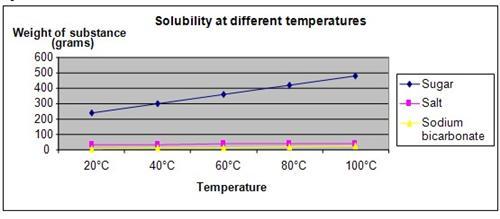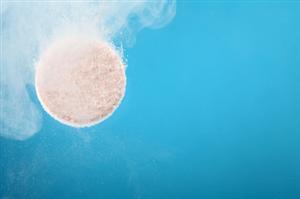| Complexity level: | 7 |
| Project cost ($): | 10 |
| Time required: | 1 hour to prepare, 2 hours for the experiment |
| Material availability: | Easily found |
| Safety concerns: | Basic safety requirements |
Hypothesis
As the temperature of the water increases, the amount of substance dissolved in the water also increases. This should be true for all types of substances.
Overview
Solubility
Solubility refers to the ability of a given volume of solvent to dissolve a substance. It is normally expressed as the amount (in grams) of substance that can be dissolved in 100ml of a given solvent at room temperature (20 °C). Most substances will become more soluble when the temperature of the solution is increased.
Some factors that affect the solubility of a substance are temperature, air pressure and the type of solvent used. The solubility of different substances will not be the same for a given solvent. For example, some substances can dissolve very easily in water whereas others may not. .
Saturation is reached when the substance cannot be dissolved in the solvent any longer. The remaining substance can only be dissolved by adding more solvent or increasing the temperature of the solvent. When the temperature of such a saturated solvent is gradually reduced, crystals will start to form inside the solvent.
Scientific Terms
Materials
The materials required for this science fair project:
- 3 beakers
- 300ml water
- Some ice cubes
- 1 measuring cylinder
- 1 hot plate
- 1 thermometer
- 1 kg sugar
- 100 grams salt
- 100 grams sodium bicarbonate
- 1 digital weighing scale
- 1 spatula
Procedure
1. For this experiment, the independent variable is the temperature of the solvent (water) and the type of substance used – sugar, salt and sodium bicarbonate. The dependent variable is the amount of substance dissolved in the water. This is determined by measuring the weight of the substance using the digital weighing scale. The constants (control variables) are the type of solvent (water), the amount of water used and the air pressure in the room.
2. The 3 beakers are labeled as “sugar”, “salt” and “sodium bicarbonate”.
3. The temperature of the water is brought to 20°C by adding some ice cubes to the water. Once the temperature of the water has stabilized, 100ml of the water is measured using the measurement cylinder and poured into each of the 3 beakers.
4. Sugar is added, 10 mg at a time, to the beaker labeled “sugar” and it is mixed using the spatula. The sugar is continuously added until it is not able to dissolve in the water anymore. The amount of sugar that has been added is calculated and recorded in the table given below.
5. The beaker is now placed on the hot plate and the temperature of the solution is brought to 40°C. The sugar is again added, 10mg a time, until it does not dissolve in the water anymore. The total sugar added (including the sugar previously added) is calculated and recorded in the table below.
6. Step 5 is again repeated at 60°C, 80°C and 100°C and the results are recorded in the table below.
7. Steps 4, 5 and 6 are again repeated using salt and sodium bicarbonate. However these 2 substances will be added to the water 1mg a time instead of the 10mg used for sugar. The results are recorded in the table below.

Results
The results show that as the temperature of the water increases, the amount of sugar, salt and sodium bicarbonate dissolving in the solution is also higher.
|
Substance |
Weight of substance dissolving in the water at different temperatures (gram) |
||||
|
20°C |
40°C |
60°C |
80°C |
100°C |
|
|
Sugar |
240 |
300 |
360 |
420 |
480 |
|
Salt |
35 |
36 |
37 |
38 |
39 |
|
Sodium bicarbonate |
10 |
13 |
16 |
20 |
24 |
The graph below represents the results of our science project experiment.

Conclusion
The hypothesis that as the temperature of the water increases, the amount of substance dissolved in the water also increases, is proven to be true.
Solubility of a substance in a solvent can be increased or reduced by adding another substance. For example, adding salt in a solution saturated with sugar will enable more sugar to be dissolved in the solution. This technique is used in candy making. .
Also consider
Try to repeat the experiment by using other substances like calcium chloride, potassium permanganate or iron sulfate.
The experiment can also be repeated using different solvents like alcohol or benzene.
References
Effect of temperature on solubility - http://preparatorychemistry.com/Bishop_solubility_temperature.htm
Solubility of substances in solution - http://chestofbooks.com/food/science/Experimental-Cookery/Solubility-Of-Substances-In-Solution.html
Solubility in water - http://www.lenntech.com/air-purification/gas-purification-techniques/solubility-in-water.htm

